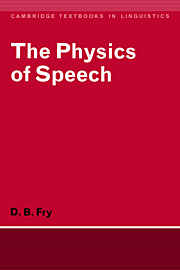Book contents
- Frontmatter
- Contents
- List of phonetic symbols
- 1 The speech chain
- 2 The generation of sound
- 3 The propagation of sound waves
- 4 Absorption and reflection of sound energy
- 5 Free and forced vibrations: resonance
- 6 The speech mechanism as sound generator
- 7 The vocal tract
- 8 Periodic and aperiodic sounds
- 9 Acoustic analysis: the sound spectrograph
- 10 Acoustic features of English sounds
- 11 Acoustic cues for the recognition of speech sounds
- Index
4 - Absorption and reflection of sound energy
Published online by Cambridge University Press: 05 June 2012
- Frontmatter
- Contents
- List of phonetic symbols
- 1 The speech chain
- 2 The generation of sound
- 3 The propagation of sound waves
- 4 Absorption and reflection of sound energy
- 5 Free and forced vibrations: resonance
- 6 The speech mechanism as sound generator
- 7 The vocal tract
- 8 Periodic and aperiodic sounds
- 9 Acoustic analysis: the sound spectrograph
- 10 Acoustic features of English sounds
- 11 Acoustic cues for the recognition of speech sounds
- Index
Summary
In the discussion of travelling waves some reference has been made to the frequency of the sound vibrations but none has been made to the amplitude of the waves. Whatever frequency or indeed mixture of frequencies is generated by the sound source will be present in the soundwaves propagated in the surrounding air. The amplitude of the waves is, however, subject to a number of factors which will be discussed in the course of this chapter. The key to the matter lies in the amount of energy which is available for conversion into sound. The amplitude of vibration of the tuning-fork prong is largely determined by the strength of the blow with which we strike it; this decides the total energy that is injected into the vibrating system. The fork goes on vibrating until this energy is used up and then it ceases to move. Part of the energy is consumed in moving repeatedly the metal particles of the fork; part of it is expended in moving the air particles around the prong and in imparting energy to them. If the foot of the fork is pressed on a bench top, for example, then some of the energy is used in moving the bench on which the foot of the fork is placed, and this in turn moves the surrounding air particles. The point is simply that all the energy imparted to the fork is used up in some way; none of it is ‘lost’.
- Type
- Chapter
- Information
- The Physics of Speech , pp. 37 - 48Publisher: Cambridge University PressPrint publication year: 1979

